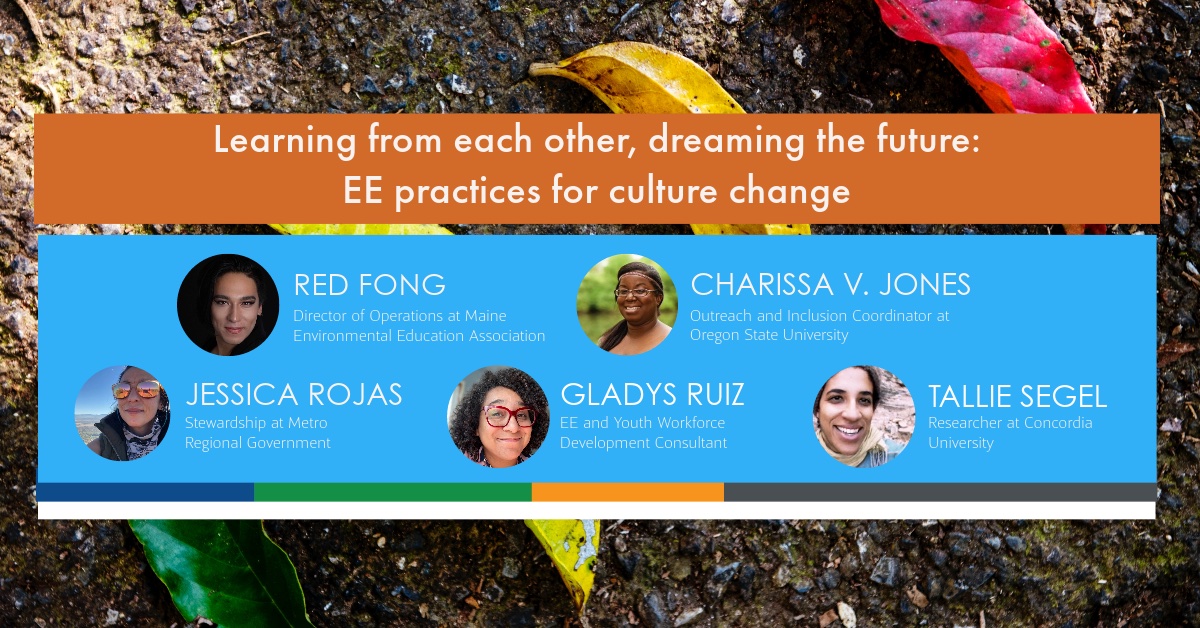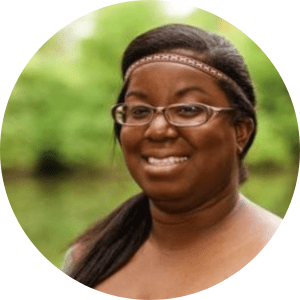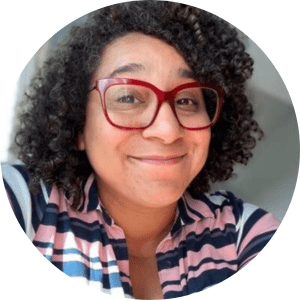Learning from Each Other, Dreaming the Future

What are the unique impacts of learning from each other, and how do we de-center western models of teaching and learning?
In late Spring 2023, NAAEE’s ee360+ Leadership and Training Collaborative and the Center for Diversity & the Environment brought together environmental educators from across the country for an intimate conversation with a panel of leaders in the EE field. What happens when environmental education centers in, and emerges from, equity, diversity, inclusion, and culture change? Find out in this intimate conversation with a panel of leaders in the EE field, as they discuss the unique impacts of their work to de-center western models of teaching and learning.
Deep gratitude for the wisdom and knowledge shared by the panelists: Charissa V. Jones, Oregon State University (OSU) Extension Service Outdoor School; Jessica Rojas, Metro Regional Government; Red Fong, Maine Environmental Education Association; Tallie Segel, Concordia University; and Gladys Ruiz, EE and Youth Workforces Development Consultant.

Following are excerpts from the discussion:
Moderator: What are the EE practices that are equitable, inclusive, and inter-generational, that de-center the ‘teacher’? What are the unique impacts of learning from each other rather than using dominant western models of teaching and learning?

Jessica Rojas: When I do a stewardship project or land tending project, I'm learning from the land and people are learning from each other. I think one of the practices that came to mind when this question came up, I thought of one of my peers who runs the Native Gathering Gardens program. Whenever we get into our work, we have an introduction circle: we say our name and our pronoun, maybe other things about who we are or where we're from. But we each model a stretch, and then passing to the next person. From right then and there everybody's teaching. Everybody's a teacher in that moment and everybody’s learning.

Charissa V. Jones: I’m going to piggy-back off of what Jessica said about everybody being a learner and a teacher. What definition are we putting on teacher, and what authority comes with that? I used to be a 3rd grade teacher in Florida. The students were always thrown off by the fact that I called them teachers. They were like, “We're not teachers. You're the teacher. Teachers tell us what to do.” That, to me, was a really uncomfortable space, where I hold all the power and the knowledge and they don't hold anything. So we spent a whole week prior to actually going outside and exploring where they talked about their fears about the outdoors. They talked about what they did with their families and their communities when they were outside. They each picked an area of the schoolyard that they wanted to be the teacher of, and then we went out and they taught all of us something about that area.

Tallie Segel: My research is around knowledge politics, environmental education and outdoor learning. And I really think about: what are the ways we make space for many ways of knowing in our learning experiences? I was doing a research project with sixth, seventh, and eighth grade students in Flagstaff while I was working on my master's thesis. We together came up with some activities to understand the narratives of nature that we're taught, and that I, as an environmental educator working in all kinds of different settings, encounter. We talked about them and deconstructed them and ultimately created new narratives through activities, reflecting and interpreting. For me, that felt like a practice of decentering. And working to build as inclusive and shared experience as possible and also making meaning together out of all of the ideas expressed in many different ways.

Gladys Ruiz: We often forget that, what we actually are trying to do is provide that connection to both the student and the natural world. There’s this healing of the relationship that has to happen and no amount of lessons, no amount of experiments, no amount of information on the crayfish or the life cycle of salmon is going to shift that unless there's time and space given to provide students with that ability to just be, and explore, and be curious. With one organization I worked with they had a lot planned. They said, "we're going to do 21 stations—we’re going to dissect a salmon here, they're going to learn the life cycle over here and then we're going to play this other game over here. And then we're also going to chop down blackberries." I asked, in your experience, what are one or 2 stations that the kids are really excited about? And the answer was the stations where they got to explore on their own. With that shift, there was this opportunity for the students to bring in the knowledge that they had around them, the pieces they already knew about fish, or experience fishing with their families, or, you know, doing a cultural event with their Tribe. Charissa, what you shared about your experience with your students and working to create comfort for them, right? It wasn't only about the specifics. The desired outcome shifts from newly found interest to exploring comfort in the natural world. What doors does that open?

Red Fong: And it kind of brings us to this question of—what are the dreams that you all have experienced? What are those little moments of magic and healing and how do those create a path towards a more equitable, just, diverse and liberated future?

Charissa V. Jones: I am someone who went to school to be an environmental educator. And it wasn't until I went back home in South America and started volunteering and working there that I really started experiencing this expanded understanding of what the environmental field looks like. Dutch is my native language, but I don't speak that really well since I moved to the United States. We went into a small village outside of my hometown in Suriname to talk to the villagers about what is important to them. And I had a very Western view of how to approach the problems, which makes sense, because my education has been predominately American. The person I was working with in Suriname knew that. She also knew I was going to learn from these community members. I remember saying to people, “Have you all thought about what pollution looks like or the aesthetics of what's changing in your village?" and they're like, “Those things are very Western things to think about. When we think about what's happening to our village because of deforestation, because of all these organizations coming in, what we're thinking about is—what is our relationship to the place? What is our relationship to non-human animals? What is our relationship to each other and then what is our relationship to people in the city? How are all of those different needs met or how are all of those different needs in competition with each other? What would it look like to have real conversations around addressing what we need to survive, addressing what the land needs, addressing what non-human animals need?” And because of the language barrier, they were saying this in Dutch. I had a translator, and I was just sitting there and thinking. And then they brought up this question: “What does it mean for you? You are from this place, but you are advocating for a western way to be in the environment that separates you.” So when I think of how to dream the future, it’s not this separation. It is—how am I thinking about the way that I exist and navigate my body on this plane in such a way that I'm also thinking about the land, non-human animals, other people? Because it's very compartmentalized, or at least for me it was very compartmentalized. And I remember just being like kind of shocked. I could not answer that question. What does it look like to live, aligning with all of those different components because I could only see myself separating from them. So when I think about dreaming the future, I think about that. I think about how, as I saw in my experience being a formal educator, our kids go from being very curious and asking questions and not having the type of fear that adults put on them in terms of engaging with place and space. Then it's third grade, at least in Florida, where you start to see that shift and change because they're forced into a system, a way of socializing that asks them to stop asking questions, that asks them to stop being curious and then asks them to just make hard line boundaries in their lives. I'm still trying to figure this out and this is part of what my doctoral research is about. What does joy look like? What would it be to just envision a space where there is liberation already? Where we already have justice?

Gladys Ruiz: I want to acknowledge that for me there was a lot of nervousness stepping into this specific space because I've been on the path of healing in the EE space, both broad and narrow definitions of it. And there's moments of pain and trauma, and then there's those moments where you're sitting by the river with young people waiting to hop in and do some snorkeling after you spent 20 min trying to get into a wetsuit and we're just sitting there waiting. And the kids are talking about their lives. They're talking about those moments of pain and trauma and then they're also sitting there flapping their legs in the water trying to get cool. It’s those moments when I'm both being a witness to and remembering what my path was to get to that moment and that reconciling. There’s a reconciliation of trauma and healing that sometimes has to occur.

Jessica Rojas: A while ago a friend and I were asked to substitute teach for somebody who's like a mentor to us and we both look up to dearly, a professor. They wanted us to step into their class. We're eager to just teach our little hearts out. I know that two of us prepared a lot. And we get there and my friend, she’s going hardcore teaching and I'm like alright, alright, she's running with it, you know? And as she's teaching at the wetlands, all these deer started to surround us. I saw them but I was just like, she's going for it and teaching. We’re just going for it. There are deer all the time, you know. I mean, do we see them? But they're really starting to surround us and they were scoping us. And I’ve never seen deer come from different directions and they're really watching us, really listening to us. And this young person, she said, ‘I'm sorry I have to interrupt. You know, I was just taught that when the animals come to us like this, we need to make an offering.’ It was just so amazing to watch her step up and lead the group in the direction where we needed to go. And after we made that offering, the deer went on. And then other people started to speak up and share. And there was so much knowledge in that space. And I was just so grateful for her giving us a place to pause. When teaching we have a lot of information, a lot of things to share. But what's so amazing is that we all do, and we all get to learn from each other.

Red Fong: Yeah, I really resonate with what you're saying. I think a lot about the dichotomy of knowing as an intellectual, knowing in the way that we know what species that is or we know what it's classification is or whatever, versus knowing as a body. And knowing as an individual. Knowing when I enter a certain environment from the smell or from the way that my body feels—oh, I’m around conifers now. The way that my body feels is distinctly different. And what y'all are sharing makes me think about the moments when we act on something because of the knowledge that our body has or the knowledge that we've allowed our body to acquire, each time that we act on that knowledge and those instances. I think those are the moments where I'm dreaming; where I'm in a conversation with someone or working with someone and something doesn't feel quite right in my body and it feels stuck. There's something about this that just isn't sitting right. I name that for myself and out loud for others in the room. Then as we get to talking about it, you eventually arrive at this idea where, it's almost like everyone's holding the same live wire together—you're all feeling the current, and it's only through those moments where someone has stopped. And that kind of re-orientation usually benefits everyone. Whenever we act on it in that way, it always leads us to a better path that we can all get on towards liberation, through joy and having fun and connection, all those beautiful things.

Tallie Segel: Thank you Red for the reminder of thinking about your embodied experience. These moments where magic and healing happens—they all have to do these tiny moments. This reminds me of a moment I had when I was teaching EE in the San Juan Islands, and during some down time during a lesson my co-instructor and I were enjoying the view of the Puget Sound and the islands to the west of Orcas Island where we were. There was a sixth grader standing between me and the other instructor, and I think we were having the same thought as we looked at the islands—are those islands floating, or are we just standing on the tops of mountains? What are these islands? You’re standing on one and you're just thinking, what am I looking at? And suddenly the student asks this very question: are these islands floating? We all laughed and we talked about it. It felt like a real synchronous moment. There was trust between the student, the other instructor and myself, to be able to ask this question. And I feel like that's such a huge part of where magic and healing happens—when there's trust. When we have that common trust and having this kind of funny connection even if it's over something tiny and these moments of joy are where the magic is happening. Red, I fully believe that that is, it's not just equity and inclusion and diversity, but that is liberation. Having those moments of connection.

Charissa V. Jones: When I think about magic and what is implied by magic, a lot of the times it’s supposed to be unique. It can't be something that's mundane. And so I'm thinking about the magic of the mundane and the healing of that in EE. Those of you who know me you know, I am obsessed with TikTok. And a couple of summers ago there was a whole thread on TikTok of Black men running through the fields and they're like “we're frolicking, we're frolicking.” I remember thinking, oh my God, that is a magical healing moment because there’s violence that's gendered and racialized. You can't just be a Black man in a field because people are going to look at you like you're doing something suspicious. And the joy that all these Black men had as they're running, as they're falling, as they're rolling around in a field—so dreaming of the future is being able to do those mundane things. That healing space of not worrying about—I can frolic in a field and nobody's thinking that I'm chasing after them or that I'm doing something suspicious and it's fun and it's joyful. Remembering that we used to do that, we do do that, we're still doing that. I think about the magic of the mundane in the environmental field and in general, and being able to find the joy in that without having to look over your shoulder. Or think about who could be confused by your presence in that space.

Gladys Ruiz: We want to talk about that—how does environmental education offer a space to practice culture change? Because that's what we're talking about, right? When Charzy talks about frolicking and the dangers and also the opportunities that it brings, what we're talking about is culture change. Where is this area where we get to be and bring our full selves, free of the assimilative qualities that the environmental education field was created out of? I was taught that the natural space is the great equalizer. And so, you know, a lot of the stories that I shared previously were all about creating space for folks to be and bring their full selves. And in order to do that you have to build trust, you have to build relationships. For me, a strategy is to, Tallie, what you said: to listen. The young people aren't blind to what's happening, right? They feel it, their bodies feel it. They're listening to it. They may have opinions on it.

Red Fong: I think as we are trying to navigate these challenges, we have to create spaces where we can sit into that feeling of love for the people that we work with. It takes a lot of care—you could just shut down and isolate yourself and then just surround yourself with people who think like you. But to care and want that change takes a lot. So we have to both hold that, and at the same time have spaces where we can retreat and rest. I think a lot about that within small spaces. I think a lot about my organization that I work for where there are sometimes intimidating people in the EE field, particularly when it comes to white cis men in conservation, where it can be very aggressive and intimidating and makes me uncomfortable. But having spaces that I know that I can rely on other people to let me continue to do that work because I know I have the care and support behind me, that I can continue to get, because not only am I filling my own cup, but I'm also supporting and filling others’ too.

Jessica Rojas: Some things that I think can help is not seeing ourselves as separate from nature, not reinforcing that separateness, looking for opportunities that are ways that we compliment or, you know, teach us about ourselves as humans. Sometimes when I look at the river and I remember the salmon, that I love, they swim upstream, up against the current and they overcome falls and barriers and I'm going to overcome barriers too. And sometimes I have to remember that when I'm up against those barriers because I just want them to go away, but I'm like, no, the strongest fish I know that go upstream and go and have their spawn in those areas, the reason why is they're the strong fish. I've been really excited about—where does language preservation exist in in our world? You know, and I'm not just talking about like, oh, how do I say this plant? Like people always want to know, how do I say this in this native language? Just like, no. But what about the act of being here on the land and harvesting? Tell me about that in your language.

Tallie Segel: Learning and relationship with the land, I've been thinking about that in a bunch of different ways. I do think our work is culture change and to Jessica's point, which is something I feel super passionate about and super excited about, how we know it’s so different depends on who we are, where we come from, who raised us, where we were raised, where and what kind of relationship with the land we have. And all of that is so important to bring into the space for outdoor and environmental learning. And, it expands our vocabulary, 100 fold, to keep moving that culture change forward. Another point for our previous question was to think about how the culturally dominant English and Western scientific thinking limits us. And what do other ways of knowing and the sort of expansiveness of many languages and ways of knowing open up?
Transcript edited for length and themes. “Learning from each other, dreaming the future: EE practices for culture change” was held on May 22, 2023 via Zoom.
Center for Diversity & the Environment is a Training Partner in the ee360+ Leadership and Training Collaborative (ee360+). An ambitious multi-year initiative, the ee360+ Leadership and Training Collaborative connects, trains, and promotes innovative leaders dedicated to using the power of education to create a more just and sustainable future for everyone, everywhere. Led by the North American Association for Environmental Education (NAAEE), ee360+ is made possible through funding and support from U.S. EPA and twenty seven partner organizations representing universities and nonprofits across the country, and five federal agencies. Through this partnership, ee360+ brings together more than five decades of expertise to grow, strengthen, and diversify the environmental education field. Visit www.ee360.org to learn more.
This eePRO blog series, Ripple Effects, highlights stories of collaboration and impact among partners in the ee360+ Leadership and Training Collaborative. ee360+ is an ambitious multi-year initiative that connects, trains, and promotes innovative leaders dedicated to using the power of education to create a more just and sustainable future for everyone, everywhere. Led by NAAEE, ee360+ is made possible through funding and support from U.S. EPA and twenty-seven partner organizations representing universities and nonprofits across the country, as well as five federal agencies. Through this partnership, ee360+ brings together more than five decades of expertise to grow, strengthen, and diversify the environmental education field.



